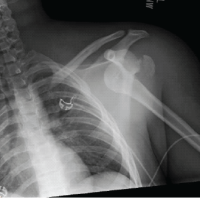[box type=”bio”] Learning Point of the Article: [/box]
It is important to follow a multimodal stepped care approach in CRPS 1 involving ankle joint and one of the primary goals of treatment should always be early mobilisation and avoiding undue immobilisation.
Case Report | Volume 9 | Issue 5 | JOCR September – October 2019 | Page 20-22 | Abhinav Jogani, Tushar Rathod, Shubhranshu S Mohanty, Prashant Kamble. DOI: 10.13107/jocr.2019.v09i05.1514
Authors: Abhinav Jogani[1], Tushar Rathod[1], Shubhranshu S Mohanty[1], Prashant Kamble[1]
[1]Department of Orthopedics, Seth Gordhandas Sunderdas Medical College and King Edward Memorial Hospital, Mumbai, Maharashtra, India.
Address of Correspondence:
Dr. Tushar Rathod,
6th floor, M. S. Building, Department of Orthopedics, Seth Gordhandas Sunderdas Medical College and King Edward Memorial Hospital, Mumbai, Maharashtra, India.
E-mail: tnrathod@gmail.com
Abstract
Introduction: The complex regional pain syndrome (CRPS) is an agonizing and disabling condition that can affect one or more extremities. Contrary to expectation, sporadic case reports about lower limb CRPS are present in literature. The usual sequence of events with respect to CRPS has always been prior trauma or inciting event, leading to manifestations. We hereby present a case of prolonged and undue immobilization without physical therapy, leading to CRPS in a susceptible phenotype. However, the unique feature of this case was severity of osteoporosis leading to bimalleolar fracture. To the best of our knowledge, there has been no case report of CRPS, leading to fracture.
Case Report: A 30-year-old female presented 2 months after trauma to the right ankle due to a fall from a bike. A radiograph of the ankle demonstrated no evidence of any bony injury. As per records, there was no evidence of ligament injury based on magnetic resonance imaging evaluation. As the patient had severe pain and swelling, she underwent conservative treatment in the form of lower limb immobilization in a non-weight-bearing below knee splintage for a period of 8 weeks. After removal of the splintage, the patient continued to have severe pain and swelling and was unable to bear weight. At this point of time, the patient presented to our clinic where follow-up radiographs demonstrated a bimalleolar fracture of the right ankle and diffuse osteoporosis involving talus-calcaneusand metatarsals. After thorough exclusion of other metabolic bone diseases based on various laboratory parameters, the diagnosis of CRPS was made as per Budapest criteria.
The case here was diligently managed with multidisciplinary approach. It emphasized on the well-designed rehabilitation of the affected extremity to interrupt the vicious cycle of disuse along with well-controlled analgesia, cognitive psychotherapy, and supervised regular physical therapy. Meticulous medical management included bisphosphonates, careful balance of analgesics including nonsteroidal anti-inflammatory drugs, opioids, and beta-blockers.
Conclusion: This case report highlights the importance of multimodal stepped care approach in CRPS 1 involving ankle joint. Our report also reiterates the relevance of early mobilization and avoiding undue immobilization.
Keywords: Complex regional pain syndrome, fracture, multimodal approach.
Introduction
The complex regional pain syndrome (CRPS) is anagonizing and disabling condition that can affect one or more extremities. Usually, its onset is triggered by a physical trauma, for example, sprain, fracture, or surgery itself [1, 2]. CRPS is commonly encountered in wrist fractures. Contrary to expectation, sporadic case reports about lower limb CRPS are present in literature [3]. Formerly known as reflex sympathetic dystrophy, the gamut of symptoms and signs is broad, including sensory dysfunction and uncharacteristic pain, characteristics of swelling and inflammation, impaired motor tasks, vasomotor instability, contracture, and osteoporosis [4]. This case report highlights atypical presentation of extreme variety of CRPS with severe osteoporosis, leading to bimalleolar fracture in ankle which was managed successfully with multidisciplinary approach.
Case Report
A 30-year-old female presented 2 months after trauma to the right ankle due to a fall from the bike. A radiograph of the ankle demonstrated no evidence of any bony injury (Fig. 1). As per records, there was no evidence of ligament injury based on magnetic resonance imaging evaluation. Consequent to severe pain and swelling patient was treated conservatively and immobilized in below-knee splintage for a period of 8 weeks. She was kept nil weight bearing for the entire duration. After removal of the splintage, the patient continued to have severe pain and swelling and was unable to bear weight. At this point of time, the patient presented to our clinic where follow-up radiographs demonstrated a bimalleolar fracture of the right ankle and diffuse osteoporosis involving talus calcaneum and metatarsals (Fig. 2). After thorough exclusion of other metabolic bone diseases based on various laboratory parameters, the diagnosis of CRPS was made as per Budapest criteria.
Discussion
CRPS is classified into Type I and Type II, based on the presence of a confirmed nerve affection. Type I, devoid of a nerve lesion, is the more common out of the two [6]. CRPS-I is a relatively rare disorder, with an estimated incidence of 26.2 per 100,000 with female predominance[1]. Inspite of various criteria laid down by various societies, diagnosis still remains elusive and subjective. There is an association with excessively tight casts and there may be a genetic predilection [7, 8]. Skin color changes (redness or cyanosis) and abnormal temperature are usually present, and there may be either sweating or dryness. Our case also showed shiny skin with brittle hair. Joint swelling with a decreased active range and greater passive range of motion is seen. There are numerous pathophysiological events that have been incriminated in the development of CRPS, including inflammation, autoimmune responses, sympathetic system derangements, distorted blood flow, and central cortical restructuring. The usual sequence of events with respect to CRPS has always been prior trauma or inciting event, leading to manifestations. We hereby present a case of prolonged and undue immobilization without physical therapy, leading to CRPS in a susceptible phenotype. However, the unique feature of this case was severity of osteoporosis, leading to bimalleolar fracture. To the best of our knowledge, there has been no case report of CRPS, leading to fracture. The paucity of data for CRPS in non-wrist joints has led to non-availability of any standard guidelines. The symptoms in the lower extremity are more refractory to intervention than those in the upper extremity [9]. All the published data for CRPS are based on anecdotal evidences. The case here was diligently managed with multidisciplinary approach. It emphasized on the well-designed rehabilitation of the affected extremity to interrupt the vicious cycle of disuse along with well-controlledanalgesia and cognitive psychotherapy. Supervised regular physical therapy including contrast baths, active range of motion exercises avoiding exacerbation of pain, graded motor imagery, mirror therapy, and passive movements after pain subsided was given. Meticulous medical management included bisphosphonates[10], careful balance of analgesics including nonsteroidal anti-inflammatory drugs, opioids, and beta-blockers [11]. Treatment with bisphosphonate is based on the notion that pain emanates from the osteopenia created by blood flow derangements and chronic disuse [12]. Once the painful osteoporosis is prevented, the patient may use the extremity better in daily life. The outcome of a recently published RCT [10] categorically establishes with high level of evidence that various bisphosphonates have an adequate safety profile and can drastically alleviate pain and enhance the functional status in patients with early disease. Obtaining adequate circulation and alleviating the pain would help the patients to use the affected part at ease. Consequently, the osteoporosis would disappear significantly. In our case after administration of zoledronic acid infusion 5mg i.v., follow-up radiographs showed significant improvement in the form of disappearance of fracture lines in juxta-articular area.
Conclusion
As demonstrated in the patient described in this case report, a multimodal stepped care approach that was successfully applied in managing a complex situation of a patient with fracture due to CRPS Type 1 and severe intractable pain of lower limb resulted in considerable and clinically relevant pain relief and restoration of pain-free movements.
Clinical Message
This case report highlights the importance of multimodal approach in CRPS 1 involving ankle joint. To the best of our knowledge, this is the first case in literature of CRPS 1, leading to bimalleolar fracture which was managed successfully with a combination of physical therapy and medical therapy involving bisphosphonates and cognitive psychotherapy. Our report also reiterates the relevance of early mobilization and avoiding undue immobilization.
References
1. de Mos M, de Bruijn AG, Huygen FJ, Dieleman JP, Stricker BH, Sturkenboom MC, et al. The incidence of complex regional pain syndrome: A population-based study. Pain 2007;129:12-20.
2. Sandroni P, Benrud-Larson LM, McClelland RL, Low PA. Complex regional pain syndrome Type I: Incidence and prevalence in Olmsted county, a population-based study. Pain 2003;103:199-207.
3. Saranita J, Childs D, Saranita AD. Spinal cord stimulation in the treatment of complex regional pain syndrome (CRPS) of the lower extremity: A case report. J Foot Ankle Surg 2009;48:52-5.
4. Veldman PH, Reynen HM, Arntz IE, Goris RJ. Signs and symptoms of reflex sympathetic dystrophy: Prospective study of 829 patients. Lancet 1993;342:1012-6.
5. Harden RN, Bruehl SP. Diagnosis of complex regional pain syndrome: Signs, symptoms, and new empirically derived diagnostic criteria. Clin J Pain 2006;22:415-9.
6. Wong GY, Wilson PR. Classification of complex regional pain syndromes. New concepts. Hand Clin 1997;13:319-25.
7. Mailis A, Wade J. Profile of Caucasian women with possible genetic predisposition to reflex sympathetic dystrophy: A pilot study. Clin J Pain 1994;10:210-7.
8. Mailis A, Wade JA. Genetic considerations in CRPS. In: Harden RN, Baron R, Janig W, editors. Complex Regional Pain Syndrome. Vol. 22. Seattle: IASP Press; 2001. p. 227-38.
9. Poplawski ZJ, Wiley AM, Murray JF. Post-traumatic dystrophy of the extremities. J Bone Joint Surg Am 1983;65:642-55.
10. Borchers AT, Gershwin ME. Complex regional pain syndrome: A comprehensive and critical review. Autoimmun Rev 2014;13:242-65.
11. Visitsunthorn U, Prete P. Reflex sympathetic dystrophy of the lower extremity: A complication of herpes zoster with dramatic response to propranolol. West J Med 1981;135:62-6.
12. Adami S, Fossaluzza V, Gatti D, Fracassi E, Braga V. Bisphosphonate therapy of reflex sympathetic dystrophy syndrome. Ann Rheum Dis 1997;56:201-4.
 |
 |
 |
 |
| Dr. Abhinav Jogani | Dr. Tushar Rathod | Dr. Shubhranshu Mohanty | Dr. Prashant Kamble |
| How to Cite This Article: Jogani A, Rathod T, Mohanty S, Kamble P. Bimalleolar Fracture Secondary to Complex Regional Pain Syndromeafter Prolonged, Undue Immobilization: A Case Report. Journal of Orthopaedic Case Reports 2019 Sep-Oct; 9(5): 20-22. |
[Full Text HTML] [Full Text PDF] [XML]
[rate_this_page]
Dear Reader, We are very excited about New Features in JOCR. Please do let us know what you think by Clicking on the Sliding “Feedback Form” button on the <<< left of the page or sending a mail to us at editor.jocr@gmail.com








